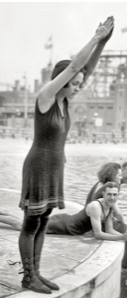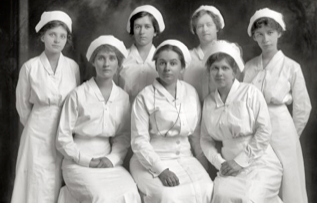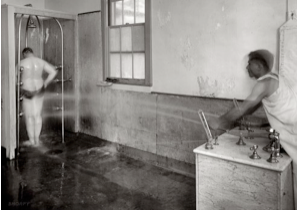The Complete Surgical Survival Guide
Prepping for Surgery and Reconstruction, What to Expect
Before, During & After
Healing & Recovery and When to call the Doctor

When you are scheduled for surgery, it is best to do as much as possible beforehand. Find out every detail from your doctor. For example, will there be lifting restrictions? If so, you need to prepare things at home so you won't harm your healing by lifting too much, too soon.
What to Wear the Day of Surgery
Whether you are having a lumpectomy or a full mastectomy with or without reconstruction, the wardrobe is the same:
Easy to slip on pants, like sweatpants or yoga pants
Easy to slip on shoes, like flip flops, clogs or comfy flats
A button down shirt. After surgery you won't be able to put your arms over your head so get a baggy button down blouse.
Make Up
If you absolutely, positively cannot leave the house without your "face" you can use:
Waterproof Mascara
Long Wearing Foundation or use some self- tanner for faces a few days ahead of time
Chapstick or Burt's Bees Lip balm
What to Pack
If you are going to ambulatory care for a day-op procedure, take as little as possible.
If you are being admitted, you will have to take off all your clothes and put your coat, bag, clothes, shoes in a plastic hospital bag that is then (supposedly) shipped off to your room.
Don't bring any valuables. Leave the cell phone at home, Do Not bring a credit card and have no more than $5 on you. Remember, what you wear is what you will be wearing home, so a pull-over sweater won't do when it is time to come home. Think about how much you can fit into a medium sized, plastic shopping bag when you are getting dressed that morning. If you don't think the bulky Ugg boots will fit, wear slip on shoes.
If you pack a bag, make sure it is not too heavy. Put in a button down nightshirt, but you may wind up wearing your hospital gown the whole time. Make sure the nightshirt has wide arm openings so you can get an IV through it and, also, your arms may swell and you want loose fitting clothes. Wearing satiny pajamas makes moving in and out of bed easier. But if you are having reconstruction that involves a surgical site around your abdomen, you may want to think carefully about what kind of waist you want the PJ bottoms to have. Loose is best.
Toiletries for your Hospital Bag:
Moisturizer for face and body
Lip Balm
Hard candy (your mouth may be dry after surgery)
Toothpaste and Toothbrush
Body Wash Cloths (You can use baby wipes)
Lightweight Book (Paperback), glasses,
Makeup
Baby Powder (travel size)

Get everything you can before the surgery so you don't have to do anything once you are home. Ask your doctor for all the prescriptions he might give you after surgery, now, so you don't have to get them filled.
Go Food Shopping
Stock up on heavier items such as soda, cans of soup, dog food, cat litter, bag of ice, etc.
Buy foods that you can cook now and freeze for later use. Put them into individual serving containers.
Buy frozen dinners that you enjoy.
Buy long lasting milk, such as Lactaid, which has an extended expiration date so it won't go bad.
Use paper plates so you don't have to worry about washing up later.
If you use two-litre size bottles of soda, switch to one litre size for less weight.
Divide up dry dog food and cat litter into small containers, rather than trying to pick up a 20 pound box. Switch to quarts from half gallons in milk.
Move everything to a lower level. If you normally keep your cereal or soups on a high shelf, move to counter-height in case you can't move your arms up.
Go to the Pharmacy
Get all your prescriptions filled.
Buy stool softeners, Senekot, etc. in case your pain killers cause constipation.
Buy Immodium AD in case your antibiotics make you go the other way
Buy Alcohol Wipes for use while stripping drains. (See How To Milk A Drain)
Buy Tylenol, Alleve, cortisone cream, gauze pads, paper tape and bandaids.

You will arrive about two hours before your surgery. You will have not eaten for at least twelve hours beforehand.
You will be nervous and that is perfectly normal. Just remember that it is these moments leading up to the operation that are the most nerve racking. Once you get your IV and the Anesthesiologist gives you your cocktail, you will sleep throughout the entire thing and the next thing you see after the IV is started is a nurse or doctor telling you it is all over, time to wake up.
You will have pre-op questions to answer. These are the exact same questions they asked you in pre-surgical testing. They like repetition.
You will be asked to remove all your clothes and to put on a gown with the opening in the back and another with the opening in the front. You will get socks with rubber treads on them. And, the piece de resistance, you get a hat. Lovely, paper and puffy... it looks like a blue Jiffy Pop Popcorn container on your head.
Your anesthesiologist will meet with you and go over your history. Your doctor will come in and tell you everything will be fine. The anesthesia nurse will ask you the same things the anesthesiologist just did. And finally they take you to the OR.
The OR is the equivalent of Ice Station Zebra. The staff will give you warm blankets. They will put a seatbelt around your hips. They will start the IV and you will see about ten people mulling about as well as your doctor in his surgery outfit. For some reason, they always look better in their scrubs. Everyone will be wearing hats. Yours is the only one that looks like a Jiffy Pop, however. They will put oxygen around your nostrils, it smells like Saran Wrap.
The Anesthesiologist will ask you how you are feeling. This is your first clue he has just started the Margarita in your IV. Your second clue is your forehead turns numb and you start to feel really good. At this time, you may tell your doctor or the nurse that you are in love with them. Then, you are asleep.

If you are getting a lumpectomy, they will cut around the tumor. They will make the cut larger than the tumor itself to clear the tissue surrounding it so they can measure the spread of your cancer. This is known as your margins.
They may inject your tumor with a dye that they can follow to your first lymph node, known as the sentinel lymph node, and they will test that node for cancer. If negative, they close you up. If it is positive, they remove the entire lymph node sac so they can measure how many have cancer cells in them.
If you are getting a mastectomy, your Breast Surgeon will remove all the breast tissue under the skin of your breast and along the side of you breast toward your underarm. Most doctors spare the breast skin today. So they hollow it out like you would take an avocado out of its shell.
If you are not getting reconstruction, your doctor will sew you up and the surgery is completed.
If you are getting reconstruction, your Plastic Surgeon now steps in. What the Breast Surgeon takes away, the Plastic Surgeon replaces.
The Types of Reconstruction are explained HERE.
If you are getting implant reconstruction, the plastic surgeon will place tissue expanders where the implants will eventually go. They will be expanded with injections of saline over the next several months until your desired breast size is achieved. At a later date, you will have your implant exchange.
If you are having your breast recreated from another part of your body, your plastic surgeon will first operate on that area, often performing micro-surgery to separate the blood vessels to reattach to your chest's blood vessels, making your new breasts become living, warm tissue.

You will wake up feeling loopy. You may or may not feel any pain. Ask for medication if you are in pain.
You will be in the recovery room where the nurses take very good care of you. If you are in day-op, you will soon be asked to sit up. When you are able to do that, they will take you to the restroom. They then get you dressed and have you sit in a chair for a while until you are steady enough to go home. When you get home, rest. Don't overdo anything. Follow your doctor's instructions to the letter.
If you are staying in the hospital, you will be in recovery for a few hours and after the doctor has seen you, they send you up to your room. You will most likely have a catheter so there will be no need to use the bathroom. Once you are settled in your hospital bed, which is about one thousand times more comfortable than the recovery room bed, you will meet the floor staff. The nurse in charge will come in and so will the orderlies and the nurse's aids.
You will be instructed on how to use pain medication if you are attached to a pain pump. If you are not on a pain pump, you will have to remind the staff when your next pain pill is due. It is best to allow them 30-45 minutes leeway to answer your request, find your chart, check your chart, find the pill, bring you the pill and give you water to take the pill.
You will have drains. See our DRAIN CARE section for more information on drains.
The next morning is usually when they take out the catheter and get you up and moving. The more you move the better you will feel. The respiratory people will come and show you how to do breathing exercises to help you get the anesthesia from your lungs.
Ask for extra pillows to prop up your arms while you are lying in bed. Pillows are scarce in hospitals, so if they tell you they have none, ask for two blankets you can roll up and prop up under your arms. Allow three hours for this request to be responded to.
You will be awakened every thirty minutes by doctors coming in to see you or your roommate; by the nurse on call who has to take your temperature and blood pressure; by the blood lab tech who draws your blood and by your roommate's visitors, her phone calls and her complaints about her treatment. You will not sleep until you go home.
When you are up and mobile, bring your bottle of soap or your baby wipes with you to the bathroom. Hospitals give both occupants of the room one anorexic bar of ivory soap to share. You do not want to share soap with anyone. Especially in a hospital. Also, keep an eye on the roommate's visitors. Even though they are not allowed, they use the patient bathroom. Keep in mind the amount of infections that people acquire during hospital stays and be proactive in protecting yourself.
Hopefully, your will be released to your home, where you can get proper rest and feel comfortable again.

One thing to remember: Every day you will feel better. You will regain your strength, stamina and start to see improvement. Once your drains are removed, you will feel 100 times better.
Proper drain care is important, please follow our instructions.
Eat a high protein diet and lots of dark green veggies. Get plenty of vitamin C, too. This all aids in your healing process.
When you are given the okay by your doctor, you can take a shower. You may find you need assistance, at first.
You will feel so much better afterwards. If you have drains, connect them to a gauze necklace that you have tied around your neck. Don't forget to moisturize when you come out.
You may find you are more comfortable sleeping in an arm chair or recliner the first few days. You can also build a nest in your bed with pillows surrounding your back and arms. When you go to bed, wear slippery, satiny PJs. It helps to slide in and out of bed. Also, make sure the sheets are tucked in securely at the end of the bed, because you can pull on them to help lift yourself up when you try to get out of bed.
Take your pain meds before the pain gets too bad. It is easier to prevent pain than it is to stop it when you are feeling terrible.
Don't expect miracles. The results won't be known for months. You are a work in progress right now. Don't fret about scars, lumps or bumps or swelling. It all improves with time. And that which does not improve can be fixed by your plastic surgeon in the second stage of your surgery down the road.
Be sure to move your arms. Do gentle arm exercises, as permitted by your doctor, to keep from getting what is known as a frozen shoulder.
Don't be a hero. No, you cannot pick up that baby, dog, coffee table or stew pot. Not yet. You have to heal and if you violate the lifting restrictions you can ruin your surgical outcome.
Move it. Get up and out. Take a walk every day. It could be to the end of the driveway or around the block. Walking is good for healing.
You will be seeing your doctor weekly, so anything that is bothering you can be brought up then.
Your skin may be itchy from the surgical tape. Use the cortisone cream you bought ahead of time to take care of that.
Be Patient. It will all come together. You'll see.

Some things, like mild to moderate pain and swelling, are the normal post op changes our bodies go through after surgery. However, there are other things that you must not wait out. Call your doctor if you experience any of the following:
Temperature above 101 degrees
Bleeding
Your Drain comes out
Your Drain stops draining
Excessive swelling and heat
Trouble breathing
Sudden pain in your lower leg with swelling that is tender to the touch
POST SURGICAL ARM EXERCISE GUIDE
Exercise
When you leave the hospital or ambulatory care center you should be given arm exercises. We cannot stress enough how important these are to do. The arm exercises ensure that you do not lose any mobility in your arm. Many nerves were severed and they can tighten up while they are healing. If they tighten up while you are keeping your arm immobile then you risk getting what is known as a ‘frozen shoulder’ or an arm you can’t move.
The exercises also reduce the pain you may feel post surgically. There will be residual lightening bolts of pain that come and go like a quick zap, for a couple of years after your surgery. These are perfectly normal. There is an achiness in the shoulder blade that is quite painful and the best thing for it is to keep moving by doing your exercises. However, you may always feel an
achiness in your shoulder from time to time. It is nothing to be concerned about.
Stretching and an anti-inflammatory help to ease discomfort. However, you should check with your doctor before taking any medication.
The best exercises are started slowly and you build them up with time.
They include:
Exercise
When you leave the hospital or ambulatory care center you should be given arm exercises. We cannot stress enough how important these are to do. The arm exercises ensure that you do not lose any mobility in your arm. Many nerves were severed and they can tighten up while they are healing. If they tighten up while you are keeping your arm immobile then you risk getting what is known as a ‘frozen shoulder’ or an arm you can’t move.
The exercises also reduce the pain you may feel post surgically. There will be residual lightening bolts of pain that come and go like a quick zap, for a couple of years after your surgery. These are perfectly normal. There is an achiness in the shoulder blade that is quite painful and the best thing for it is to keep moving by doing your exercises. However, you may always feel an
achiness in your shoulder from time to time. It is nothing to be concerned about.
Stretching and an anti-inflammatory help to ease discomfort. However, you should check with your doctor before taking any medication.
The best exercises are started slowly and you build them up with time.
They include:

Get a ball that has ‘give’ to it but not a lot. It should fit in your hand. Hold your arm higher than your heart and your hand facing up, gently squeeze it. Build up repetitions based on how you feel.

Cross one arm over the other with elbows at shoulder height. Touch your fingers to your elbows and then push your arms open by having your elbows back - put
emphasis on contracting the shoulder blades.
Repeat with the other arm on top.

The Spider Crawl
Stand in front of a wall. Bend your forearms up and lean them against the wall.
Slowly, like a spider, crawl your fingers up the wall until you feel a stretch and feel you cannot go any further. Hold that stretch for a couple of seconds. The more you do this the higher you will be able to go.
Do as many reps as you can, increasing the number of repetitions slowly as you start to tolerate more.

The Praying Mantis
Stand with your arms at straight out in front of you, put your palms together as if you were praying. Then interlock your fingers and slowly raise you arms up over your head. GO SLOWLY. Gently, and as best you can, bring your hands to the back of your neck and then close your elbows together so that your elbows are sticking out from your chin. Do this slowly. If you feel sharp pain stop and try
again later.
Exercise Preserves Freedom of Movement After Breast Cancer Surgery
Washington, June 16 (ANI): A study has found that exercise can help patients maintain shoulder movement and minimize loss of arm or shoulder function after breast cancer surgery.
The new Cochrane review found exercise programs needed to be created to help patients who have just had surgery, as most survivors develop pain, shoulder stiffness and arm swelling after treatment.
Physicians usually prescribe arm and shoulder exercises after surgery to prevent pain and stiffness in those areas on the side of the cancer, but the problems often persist for years.
"There has been some concern that too much aggressive movement soon after surgery might cause pain, delay healing, and increase the risk of arm swelling," said lead review author Margaret McNeely, an assistant professor of physical therapy at the University of Alberta and clinical researcher at the Cross Cancer Institute, in Canada.
McNeely's team examined 24 research studies comprising 2,132 women with a confirmed breast cancer diagnosis and who had undergone surgery such as a radical mastectomy, modified radical mastectomy, or a local wide excision or lumpectomy.
They had also all had surgery removing lymph nodes from the axilla, or armpit, to determine the extent of the cancer.
Specially designed programs included range-of-motion movements for the shoulders and stretching exercises.
The review showed that starting exercise early after surgery, within the first to third day, might result in better shoulder movement in the early weeks following surgery.
"However, starting exercise that soon after surgery may cause more wound drainage and require drains to remain in place longer than if exercise is delayed by about one week," McNeely said.
The Cochrane Collaboration, an international organization that evaluates medical research, published the review.
Fourteen studies compared the effect of structured exercise to usual care, in which women received an exercise pamphlet or no exercise instruction at all.
Of these, structured programs including physical therapy regimens in the early postoperative period led to a significant improvement in shoulder range of motion over the short and long term.
"Several persistent complications can greatly diminish a patient's quality of life," said Douglas Blayney, M.D., medical director at the University of Michigan's Comprehensive Cancer Center.
Blayney said that although current surgical treatment is attempting to move away from disturbing the axilla, more women, especially younger women, are choosing mastectomy over breast conserving surgery.
"Combined, these trends in primary treatment of breast cancer make this review highly relevant," said Blayney, who has no affiliation with the review.
Nevertheless, he noted that making suitable exercise programs widely available to breast cancer patients in a timely manner would be a challenge.
He said optimal breast cancer care now involves a team with a wide range of health specialists: surgeons, radiation oncologists, medical oncologists, reconstructive surgeons and others.
"This review demonstrates that early involvement of a new team member who manages exercise or physical therapy is also useful for the best outcome," he said.
"Implementation of modern primary treatment strategies - - including early intervention with suitable exercises - should reduce the incidence of these heartbreaking complications," Blayney added. (ANI)
Washington, June 16 (ANI): A study has found that exercise can help patients maintain shoulder movement and minimize loss of arm or shoulder function after breast cancer surgery.
The new Cochrane review found exercise programs needed to be created to help patients who have just had surgery, as most survivors develop pain, shoulder stiffness and arm swelling after treatment.
Physicians usually prescribe arm and shoulder exercises after surgery to prevent pain and stiffness in those areas on the side of the cancer, but the problems often persist for years.
"There has been some concern that too much aggressive movement soon after surgery might cause pain, delay healing, and increase the risk of arm swelling," said lead review author Margaret McNeely, an assistant professor of physical therapy at the University of Alberta and clinical researcher at the Cross Cancer Institute, in Canada.
McNeely's team examined 24 research studies comprising 2,132 women with a confirmed breast cancer diagnosis and who had undergone surgery such as a radical mastectomy, modified radical mastectomy, or a local wide excision or lumpectomy.
They had also all had surgery removing lymph nodes from the axilla, or armpit, to determine the extent of the cancer.
Specially designed programs included range-of-motion movements for the shoulders and stretching exercises.
The review showed that starting exercise early after surgery, within the first to third day, might result in better shoulder movement in the early weeks following surgery.
"However, starting exercise that soon after surgery may cause more wound drainage and require drains to remain in place longer than if exercise is delayed by about one week," McNeely said.
The Cochrane Collaboration, an international organization that evaluates medical research, published the review.
Fourteen studies compared the effect of structured exercise to usual care, in which women received an exercise pamphlet or no exercise instruction at all.
Of these, structured programs including physical therapy regimens in the early postoperative period led to a significant improvement in shoulder range of motion over the short and long term.
"Several persistent complications can greatly diminish a patient's quality of life," said Douglas Blayney, M.D., medical director at the University of Michigan's Comprehensive Cancer Center.
Blayney said that although current surgical treatment is attempting to move away from disturbing the axilla, more women, especially younger women, are choosing mastectomy over breast conserving surgery.
"Combined, these trends in primary treatment of breast cancer make this review highly relevant," said Blayney, who has no affiliation with the review.
Nevertheless, he noted that making suitable exercise programs widely available to breast cancer patients in a timely manner would be a challenge.
He said optimal breast cancer care now involves a team with a wide range of health specialists: surgeons, radiation oncologists, medical oncologists, reconstructive surgeons and others.
"This review demonstrates that early involvement of a new team member who manages exercise or physical therapy is also useful for the best outcome," he said.
"Implementation of modern primary treatment strategies - - including early intervention with suitable exercises - should reduce the incidence of these heartbreaking complications," Blayney added. (ANI)
The No Surrender Breast Cancer Foundation is a 501 c 3 Not-For-Profit Organization. Please see our Disclaimer and Terms of Use.